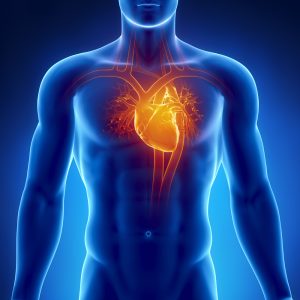Coronary heart disease and physical activity
Coronary Heart disease: definition and symptoms
Coronary heart disease (CHD), also known as coronary artery disease, is the leading cause of death in the Grand-Duchy of Luxembourg, accounting for 13% of all deaths and 35% of deaths from cardiovascular disease [1]. CHD is the accumulation of different substances (e.g. fatty material) forming a plaque build-up on the walls of coronary arteries. The narrowing of these blood vessels decreases the amount of blood and oxygen supplied to the heart muscle which may induce symptoms like chest pain and discomfort [2]. The main modifiable risk factors are physical inactivity, smoking, high blood pressure, blood lipid disorders, overweight/obesity and diabetes [3].
The effects of physical activity on coronary heart disease?
Physical activity decreases inflammation and limits the narrowing and the stiffness of the blood vessels, through the involvement of different vasoregulative factors [4, 5]. It also modifies heart muscle function, especially to increase its contractility and stroke volume. Blood pressure and heart rate are reduced by physical activity via, among other factors, a better regulation of the autonomous nervous system [5]. Exercise training helps to prevent other CHD risk factors such as obesity and its associated diseases (e.g. diabetes, hypertension, blood lipid disorders). Physical activity also helps patients to develop and maintain an active and healthier lifestyle, and consequently increase their psychological wellbeing and lower future cardiovascular risk.
What are the risks?
The risk of cardiovascular events during supervised physical activity is relatively low and ranges from 1/50 000 to 1/750 000 person-hours of exercise. Daily strenuous training increases the risk of death [6]. It is therefore recommended to perform adapted and supervised physical activity, especially in the first months after a diagnosis of CHD.
Recommendations
Physical activity is strongly recommended to prevent the development of CHD (primary prevention) and during all cardiac rehabilitation phases following the first event (secondary and tertiary prevention). However, it must be lifelong change in order to prevent relapses. Physical activity guidelines recommend 30-60 minutes per day, on 3-5 days per week, of moderate intensity aerobic exercise, e.g. cycling, jogging, swimming, aquafit classes, dance or ball sports [7]. Exercise intensity should be within 50-80% of maximal heart rate [7]. Resistance training should consist of 1-3 sets of 8-10 different exercises (10-15 repetitions for each exercise at 65-75% of maximal weight that can be lifted) on 2-3 days per week [8]. Exercise should not be perceived as hard on the rating of perceived exertion (≤ 14 points on the Borg’s scale). Isometric training is not recommended due to possible elevation of pressure on heart muscle. A relaxation program with breathing exercises is recommended during aerobic or resistance exercises or at rest. It consists of exercises addressing body perception, stress, anger, and depression [9].
Related groups
- Association Luxembourgeoise des Groupes Sportifs pour Cardiaques – Section Sud
- Association Luxembourgeoise des Groupes Sportifs pour Cardiaques – Section Nord
- Association Luxembourgeoise des Groupes Sportifs pour Cardiaques – Section Centre
References
- World Health Organisation. Disease and injury country estimates – Burden of disease. 2011 [cited 2014 09/09/2014]; Available from: http://www.who.int/healthinfo/global_burden_disease/estimates_country/en/.
- Medlineplus. Coronary heart disease. 2012 6/22/2012 [cited 2014 09/09/2014]; Available from: http://www.nlm.nih.gov/medlineplus/ency/article/007115.htm.
- Lilly LS. Braunwald’s heart disease: a textbook of cardiovascular medicine. Vol. 1. 2012: Elsevier Health Sciences.
- Lara Fernandes J, Serrano CV, Jr., Toledo F, et al. Acute and chronic effects of exercise on inflammatory markers and B-type natriuretic peptide in patients with coronary artery disease. Clin Res Cardiol 2011;100(1):77-84. Available at: http://dx.doi.org/10.1007/s00392-010-0215-x.
- Wienbergen H, Hambrecht R. Physical exercise and its effects on coronary artery disease. Curr Opin Pharmacol 2013;13(2):218-25. Available at: http://dx.doi.org/10.1016/j.coph.2012.12.003.
- Mons U, Hahmann H, Brenner H. A reverse J-shaped association of leisure time physical activity with prognosis in patients with stable coronary heart disease: evidence from a large cohort with repeated measurements. Heart 2014;100(13):1043-9. Available at: http://dx.doi.org/10.1136/heartjnl-2013-305242.
- Vanhees L, Rauch B, Piepoli M, et al. Importance of characteristics and modalities of physical activity and exercise in the management of cardiovascular health in individuals with cardiovascular disease (Part III). Eur J Prev Cardiol 2012;19(6):1333-56. Available at: http://dx.doi.org/10.1177/2047487312437063.
- Thompson PD. Exercise prescription and proscription for patients with coronary artery disease. Circulation 2005;112(15):2354-63. Available at: http://dx.doi.org/10.1161/CIRCULATIONAHA.104.502591.
- Neves A, Alves AJ, Ribeiro F, Gomes JL, Oliveira J. The effect of cardiac rehabilitation with relaxation therapy on psychological, hemodynamic, and hospital admission outcome variables. J Cardiopulm Rehabil Prev 2009;29(5):304-9. Available at: http://dx.doi.org/10.1097/HCR.0b013e3181b4ca27.
Authors & experts
Experts : Charles Delagardelle3, Axel Urhausen4.1 Luxembourg Institute of Health, Sports Medicine Research Laboratory, L-1460 Luxembourg, Luxembourg
2 Centre Hospitalier Universitaire Vaudois, Policlinique Médicale Universitaire, CH-1011 Lausanne, Switzerland
3 Centre Hospitalier de Luxembourg, Service de cardiologie, L-1210 Luxembourg, Luxembourg
4 Centre Hospitalier de Luxembourg – Clinique d’Eich, Clinique du Sport, L-1460 Luxembourg, Luxembourg
Year of publication
2015
